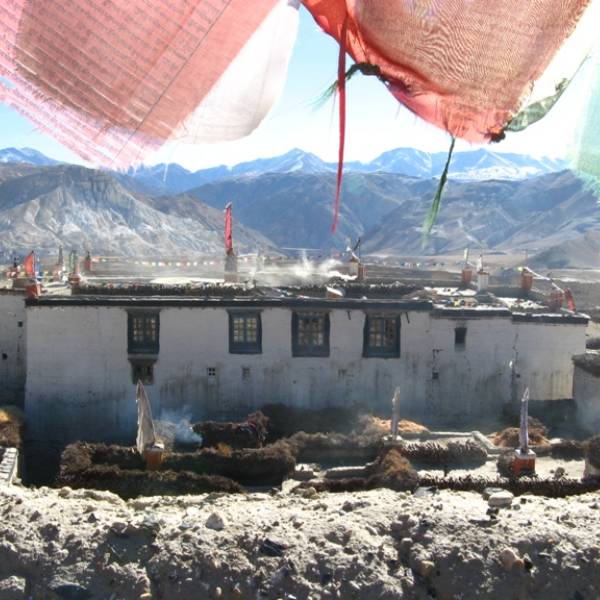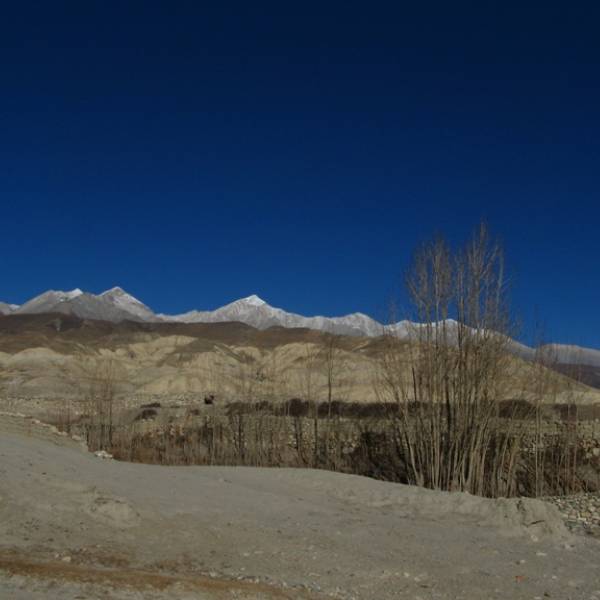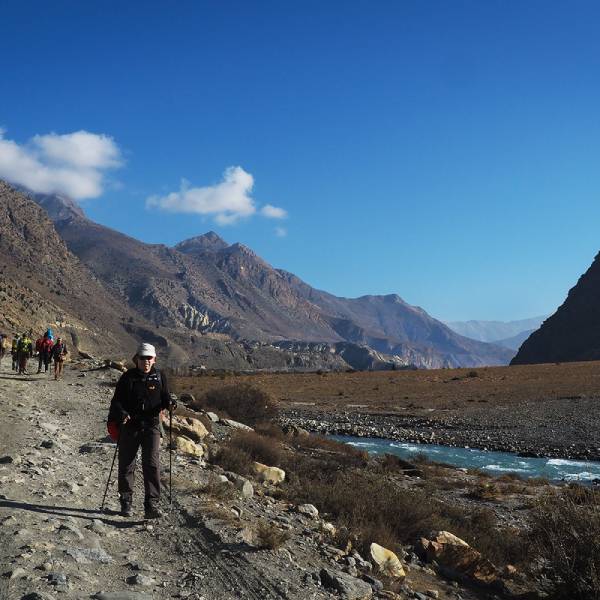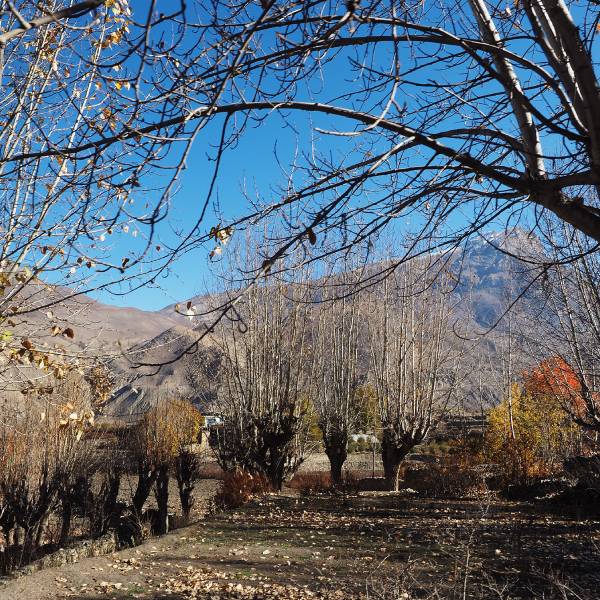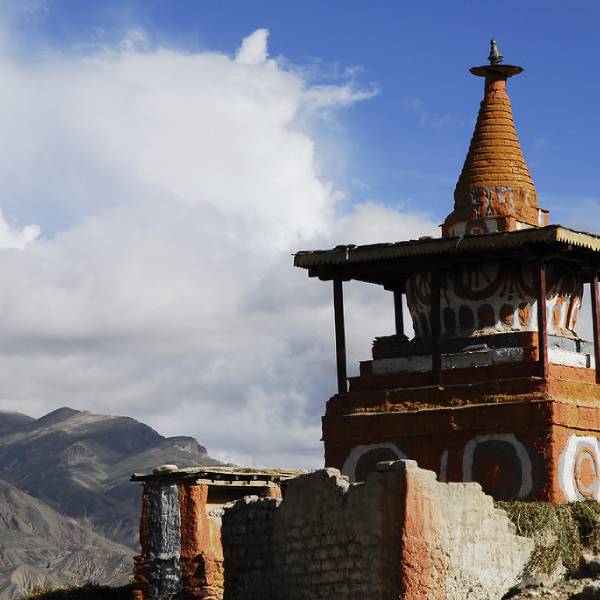Upper Mustang Trek
Tours Details
- Home
- Nepal Luxury Travel
- Upper Mustang Trek
Upper Mustang Trek
Upper Mustang remains one of Nepal’s most exclusive destinations—a windswept realm where Tibetan Buddhist culture thrives amid a dramatic high-altitude desert. Often called the "Last Forbidden Kingdom," this restricted region captivates adventurers with its ochre-hued canyons, crumbling cliffside caves, and snow-capped peaks framing villages untouched by time.
At the kingdom's heart lies Lo Manthang, a time capsule of Tibetan culture where monks in crimson-and-turquoise robes pace through narrow alleys once bustling with Himalayan salt caravans. Within its centuries-old monasteries, sunlight filters through hanging thangka scrolls depicting Buddhist cosmology, while outside, the annual Tiji Festival erupts in a mesmerizing spectacle, monks in snarling demon masks perform sacred dances to the thunderous drone of two-meter-long temple horns, their ritual footwork tracing ancient patterns in the dust.
Trekking through Mustang's surreal landscapes past crumbling red cliffs, sky-burial sites, and fields of buckwheat tended by horse-riding locals feels like stepping into a medieval Tibetan tapestry. With every prayer flag strewn pass and mani-walled trail, this high desert reveals why it remains the Himalaya’s best-kept secret: a place where culture and wilderness intertwine in breathtaking harmony.
Short Itinerary
| Title | Accommodation | Meals |
| Day 01: Arrival in Kathmandu | Hotel | |
| Day 02: Full-day Kathmandu Sightseeing | B | Hotel |
| Day 03: Drive from Kathmandu to Pokhara | B | Hotel |
| Day 04: Fly to Jomsom and trek to Kagbeni | B | Simple Lodge |
| Day 05: Kagbeni to Chele | B | Simple Lodge |
| Day 06: Chele to Syanbochen | B | Simple Lodge |
| Day 07: Syanbochen to Ghami | B | Simple Lodge |
| Day 08: Ghami to Tsarang | B | Simple Lodge |
| Day 09: Tsarang to Lo-Manthang | B | Simple Lodge |
| Day 10: Explore Lo Manthang/ Acclimatization | B | Simple Lodge |
| Day 11: Lo-Mangthang to Drakmar | B | Simple Lodge |
| Day 12: Drakmar to Ghiling | B | Simple Lodge |
| Day 13: Ghiling to Chhuksang | B | Simple Lodge |
| Day 14: Chhuksang to Jomsom | B | Simple Lodge |
| Day 15: Fly back to Pokhara | B | Hotel |
| Day 16: Drive from Pokhara to Kathmandu | B | Hotel |
| Day 17: Final Departure | B |
Tour Program
Expand AllAfter touching down at Tribhuvan International Airport, you’ll be welcomed by a Journey DMC staff member who will assist with your transfer to the hotel. Following check-in, you can unwind and settle in at your own pace.
Hotel
After breakfast at your hotel, we'll begin our immersive journey through Kathmandu's UNESCO World Heritage Sites.
Our first stop is the sacred Swayambhunath Stupa, affectionately known as the Monkey Temple, where we'll climb ancient stone steps to reach this 2,000-year-old Buddhist marvel. Gaze upon the iconic all-seeing eyes of Buddha while taking in panoramic views of the valley below, surrounded by spinning prayer wheels and playful monkeys.
From this spiritual high point, we'll descend into the bustling heart of the city to explore Kathmandu Durbar Square, an open-air museum of Newari architecture. Here, you'll witness living history at the Kumari Ghar (home of the living goddess), marvel at the intricate wood carvings of Hanuman Dhoka Palace, and stand before the imposing Kal Bhairav statue.
We'll continue to Patan Durbar Square in Lalitpur, where every corner reveals another masterpiece of Newari craftsmanship - from the stone-carved Krishna Mandir to the golden splendor of Hiranya Varna Mahavihar. As the sun begins to set, we'll return to the hotel, leaving you with vivid memories of Nepal's extraordinary cultural heritage, where ancient traditions continue to thrive amidst breathtaking architecture.
Hotel
B
After breakfast, we embark on a scenic 8-hour drive (210 km) to Pokhara, passing terraced farms, villages, and river valleys. As the Annapurna peaks emerge, we arrive at your lakeside hotel. Spend the evening relaxing by Phewa Lake, exploring Lakeside's cafes, or admiring the sunset over the Himalayas - your perfect gateway to mountain adventures.
Driving: 7-8 hrs.
Hotel
B
Begin your day with an exhilarating 20-30 minute flight from Pokhara to Jomsom, where you'll enjoy breathtaking aerial views of the Annapurna and Dhaulagiri ranges. Upon landing at Jomsom’s rustic airstrip (2,720m) - the gateway to Upper Mustang - take time to acclimatize over breakfast before embarking on your 10km (3-4 hour) trek to Kagbeni. The trail winds through the dramatic Kali Gandaki valley, passing barren hills, towering rock formations, and traditional Mustang villages, gradually revealing the Tibetan-influenced culture of the region.
Arriving in Kagbeni (2,800m), you'll discover a medieval village frozen in time, with narrow stone-paved alleys winding between whitewashed houses and ancient monasteries. Check into one of the village's cozy teahouses, where you can savor local specialties like apple pie (made from Jomsom's famous apples) while soaking in the peaceful ambiance of this high-altitude desert oasis, surrounded by the mystical landscapes of Upper Mustang.
Flight: 20 min
Hiking: 3-4 hrs.
Simple Lodge
B
Departing from the medieval charm of Kagbeni (2,800m), your trek ascends through the dramatic landscapes of Upper Mustang toward Chele (3,050m). The trail follows the Kali Gandaki River, winding past eroded cliffs and through ancient villages where Tibetan culture remains vibrantly alive. After a few hours, you'll reach picturesque Tangbe village - a cluster of whitewashed houses with colorful wooden windows, surrounded by lush apple orchards contrasting sharply with the surrounding desert-like terrain. Take time to wander Tangbe's narrow alleyways and perhaps sample fresh apples or local apple brandy before continuing your journey. The final ascent to Chele reveals increasingly spectacular views of Nilgiri and Tilicho peaks, with the landscape transforming into a colorful mosaic of wind-sculpted rock formations.
Arriving in Chele, you'll find basic but welcoming teahouses where you can rest and acclimatize while enjoying the peaceful atmosphere of this traditional village, where prayer flags flutter against the backdrop of towering Himalayan peaks - a perfect introduction to the mystical kingdom of Lo Manthang that lies ahead.
Hiking: 5-6 hrs.
Simple Lodge
B
Setting out from Chele (3,050m), your journey ascends through the breathtaking landscapes of Upper Mustang, following ancient trade routes toward Syanbochen. The trail first leads to the picturesque village of Samar, where whitewashed Tibetan-style houses adorned with colorful prayer flags stand in striking contrast against the arid mountains. Pause to admire panoramic views of Annapurna and Nilgiri peaks before tackling the challenging climb to Bhena La Pass (3,860m) - your highest point of the day. At the pass, catch your breath while soaking in 360-degree vistas of the Mustang's dramatic valleys and distant snow-capped peaks. The descent brings you through an otherworldly terrain of wind-carved cliffs and ochre-colored rock formations before arriving in Syanbochen (3,800m). Wandering through this settlement reveals three treasures: bountiful apple trees, intricately carved mani stones, and perfectly preserved Mustang dwellings. Settle into one of the local teahouses, where warm hospitality and simple comforts await after your rewarding day's trek through this mystical Himalayan landscape.
Hiking: 6-7 hrs.
Simple Lodge
B
Leaving Syanbochen (3,800m), ascend through Mustang's arid landscape to Yamdo La Pass (3,970m). After the demanding hike, you’re greeted with expansive Tibetan Plateau scenery. Cross Nyi La before descending to Ghami (3,520m) - a sprawling village of whitewashed mud homes and the historic Ghami Gompa monastery. Rest at a cozy teahouse, then explore alleyways where farmers work fields as their ancestors did, all set against Mustang's dramatic cliffs. This day blends physical challenge with cultural immersion in Upper Mustang's best-preserved traditional village.
Hiking: 5-6 hrs.
Simple Lodge
B
Departing Ghami (3,520m), the trail winds through Mustang's surreal, rust-colored canyonlands toward Dhakmar, where dramatic crimson cliffs tower above ancient cave dwellings. The challenging ascent to Marang La Pass (4,220m) – your highest point yet – rewarded with breathtaking views of the Dhaulagiri massif before descending into the historic village of Tsarang (3,560m). This medieval settlement, among Mustang's oldest, is crowned by its magnificent 16th-century Tsarang Monastery, a five-story fortress-like structure housing priceless Tibetan Buddhist artifacts. Whitewashed houses cluster around barley fields, their wooden balconies overflowing with drying crops. As you settle into one of the village's traditional teahouses, you'll witness timeless scenes of local life unfolding against the backdrop of the Annapurna range – a perfect fusion of natural grandeur and living history.
Hiking: 5-6 hrs.
Simple Lodge
B
From Tsarang (3,560m), climb through golden badlands to Lo-La Pass (3,950m) for your first breathtaking view of walled Lo-Manthang (3,810m). Enter the medieval city through ancient gates to discover 15th-century treasures: Jampa Lhakhang’s giant Buddha, Thubchen Gompa’s sacred mandalas, and whitewashed mansions with intricate woodwork. Wander cobbled streets where locals in traditional dress spin wool, their lives unchanged for centuries. As sunset paints the cliffs gold, you’ll understand why this "Forbidden Kingdom" remains Nepal’s best-preserved Tibetan cultural sanctuary
Hiking: 3-4 hrs.
Simple Lodge
B
Today unfolds at the relaxed pace of Himalayan time as you explore the medieval wonders of Lo-Manthang (3,810m). Within the city's ancient walls, 15th-century monasteries like Jampa Lhakhang and Thubchen Gompa reveal exquisite Buddhist art - from towering, gilded statues to fading murals of protector deities. The King's Palace, with its protruding wooden balconies, watches over alleyways where local women weave on handlooms and horsemen deliver supplies in timeless fashion. Climb to the rooftop of your teahouse for panoramic views of the Annapurna range meeting the Tibetan Plateau or join pilgrims circling the city walls at dusk. This is your day to absorb the living heritage of Upper Mustang - whether bargaining for Tibetan artifacts in the market, sipping butter tea with locals, or simply soaking in the atmosphere of this remarkably preserved Himalayan kingdom.
Simple Lodge
B
Setting out from Chele (3,050m), your journey ascends through the breathtaking landscapes of Upper Mustang, following ancient trade routes toward Syanbochen. The trail first leads to the picturesque village of Samar, where whitewashed Tibetan-style houses adorned with colorful prayer flags stand in striking contrast against the arid mountains. Pause to admire panoramic views of Annapurna and Nilgiri peaks before tackling the challenging climb to Bhena La Pass (3,860m) - your highest point of the day. At the pass, catch your breath while soaking in 360-degree vistas of the Mustang's dramatic valleys and distant snow-capped peaks. The descent brings you through an otherworldly terrain of wind-carved cliffs and ochre-colored rock formations before arriving in Syanbochen (3,800m). Wandering through this settlement reveals three treasures: bountiful apple trees, intricately carved mani stones, and perfectly preserved Mustang dwellings. Settle into one of the local teahouses, where warm hospitality and simple comforts await after your rewarding day's trek through this mystical Himalayan landscape.
Hiking: 6-7 hrs.
Simple Lodge
B
Departing Drakmar dramatic red cliffs, the trail traverses Mustang’s windswept valleys to Ghiling (3,810m), a tranquil village framed by golden hills and distant snow peaks. The 5-6 hour hike reveals ever-changing desert landscapes, with prayer flags fluttering over ancient cairns. Ghiling whitewashed houses and rustic teahouses offer warm hospitality amidst the stark beauty. Wander through barley fields at sunset, watching the mountains glow crimson, or chat with locals spinning wool outside their homes. This quiet haven perfectly blends rugged Himalayan scenery with authentic village life, inviting you to reflect on your journey through this forbidden kingdom.
Hiking: 5-6 hrs.
Simple Lodge
B
Leaving Ghiling's quiet embrace, you'll trek back across Mustang's rugged desert, where golden slopes and twisted rock formations stand sentinel. The 5-6 hour descent to Chhusang (3,050m) follows the Kali Gandaki River, where towering red rock formations mark your arrival at this riverside village. Settle into a cozy teahouse, savoring the warmer climate and dramatic canyon views. As evening falls, watch horse caravans cross the ancient salt-trade route, their bells echoing off the cliffs, nostalgic return to lower elevations after days in Mustang's remote wilderness.
Hiking: 5-6 hrs.
Simple Lodge
B
Your final trekking day begins with a scenic walk along the Kali Gandaki River from Chhusang to Kagbeni, passing ancient caves and apple orchards. The trail then follows the riverbed to Jomsom (2,720m), where the bustling airstrip town welcomes you back to civilization. As you arrive, reflect on two weeks traversing Mustang's medieval villages, high passes, and surreal landscapes—from Lo-Manthang's walled city to Drakmar's red cliffs. Celebrate with a hot shower and well-earned meal, reminiscing about Himalayan sunrises, prayer-flag draped passes, and the enduring spirit of this ancient Tibetan kingdom.
Hiking: 6-7 hrs.
Simple Lodge
B
Buckle up for Nepal’s most spectacular commute: 20 minutes dodging Himalayan giants, with pilots navigating valleys like aerial river runners. After landing, immerse yourself in Pokhara's lakeside charm, visit the island temple of Tal Barahi, marvel at David’s Fall cascading into underground caves, and explore the sacred Gupteshwor Mahadev cave. Don’t miss sunset views from Bindabasini Temple, where the Himalayas reflect on Phewa Lake. Transition from Mustang’s rugged beauty to Pokhara’s relaxed vibe, savoring warm hospitality and fresh lakeside dining as you reflect on your Himalayan adventure.
Tal Barahi: In Hindu lore, the Barahi boar form symbolizes the power to uproot ignorance. Her island temple becomes especially vibrant during Dashain festival sacrifices. Reach it via a scenic 10-minute boat ride from Pokhara’s lakeside, surrounded by Annapurna’s reflections. The two-tiered pagoda, accessible only by water, offers serene spirituality amid Himalayan vistas.
David’s Fall: One of Pokhara’s top attractions is the captivating Davis Falls (Devi's Fall).This unique waterfall cascades into an underground tunnel, creating a striking sight. It is named after a Swiss visitor, David, who drowned in its turbulent waters, and is also associated with the Hindu goddess Devi.
Bindabasini Temple: Bindabasini Temple, a revered Hindu shrine in Pokhara, is dedicated to Goddess Durga, the divine symbol of power and protection. Perched on a hilltop in the old bazaar, this ancient temple attracts devotees seeking blessings for strength and fertility. It remains one of the city’s oldest and most sacred religious sites.
Flight: 20 min
Hotel
B
After breakfast, embark on an 8-hour (210 km) scenic drive from Pokhara to Kathmandu. Travel time may vary depending on traffic and road conditions. Upon arrival, check in to your hotel and unwind. Spend your evening relaxing or exploring Kathmandu’s lively nightlife, with options ranging from cozy cafes to bustling bars. The day offers a smooth transition from Pokhara’s tranquility to Kathmandu’s vibrant energy.
Driving: 7-8 hrs.
Hotel
B
Spend your last morning at leisure before we transfer you to Tribhuvan International Airport for your onward flight. With memories of Nepal's wonders, we ensure a timely departure as your journey concludes.
B
Tour Includes
- Our representative will meet you at the airport and transfer you to your booked hotel.
- 3 nights hotel stay – Kathmandu double or twin room (bed and breakfast plan)
- 2 nights hotel stay – Pokhara double or twin room (bed and breakfast plan)
- 11 nights in Simple Lodge (includes breakfast and necessary trekking staff)
- Your trek will be accompanied by English-speaking local staff and porters (1 porter for every 2 guests, carrying up to 30 kg).
- All ground transportation will be carried out according to the itinerary in a private, air-conditioned vehicle equipped with bottled water and wet wipes.
- TIMS card.
- English guide for the Kathmandu tour
Tour Excludes
- Nepal visa fees.
- Domestic and international airfares and taxes. Separately cited.
- Meals not listed in the itinerary.
- Snacks, tips, bottled drinks, and bar bill.
- All types of insurance and rescue.
- Costs incurred due to flight cancellations/road blockages/landslides and reasons beyond our control.
- Personal and other expenses not included in the above costs.
- Tips for hiking staff, hiking guides, city guides, and drivers.
- Excess baggage charges
- Personal Insurance – Comprehensive travel insurance is recommended to cover travel and flight cancellations, loss of valuables, theft, illness, accidents, and hospitalization.
- Entrance fees to the monuments listed in the program above.
FAQ
Expand AllØ The Upper Mustang Trek is an adventure that takes you into the remote region of Mustang, known as the "Forbidden Kingdom." It offers a unique blend of natural beauty and Tibetan culture.
Ø The best time for this trek is during the spring (March to May) and autumn (September to November) when the weather is pleasant, and the skies are clear.
Ø This trek is moderately challenging and involves high altitudes, so it's recommended for experienced trekkers with prior high-altitude trekking experience.
Ø While not mandatory, a guide is highly recommended for navigating the complex trails and for cultural insights. Restricted area permits require you to be accompanied by a registered guide.
Ø You will need the Annapurna Conservation Area Permit (ACAP), the TIMS (Trekkers' Information Management System) card, and a special Upper Mustang Permit, which is issued by the Nepal government.
Ø A high level of physical fitness is essential due to the rugged terrain, long trekking days, and high altitudes. Cardiovascular training and strength are beneficial.
Ø Essentials include warm clothing, sturdy trekking boots, a down jacket, a sleeping bag suitable for cold weather, and a daypack. Pack as lightly as possible.
Ø Highlights include exploring the unique Tibetan culture, visiting ancient monasteries and caves, witnessing stunning desert landscapes, and experiencing the remote and untouched nature of Mustang.
Ø Some customization is possible, but be aware that the Upper Mustang region has strict regulations, so additional side trips may require additional permits. Discuss options with your trekking agency.
Ø Yes, altitude sickness is a concern as you'll be trekking at high altitudes. Proper acclimatization and monitoring are crucial to minimize the risk.
Ø Accommodations in Upper Mustang are basic, and teahouses may not be as developed as in other trekking regions. You'll likely stay in lodges with shared facilities.
Ø It's best to book through a reputable trekking agency well in advance. They can help with permits, accommodations, and logistics, which are particularly important for this restricted region.
Ø Yes, you can combine the Upper Mustang trek with the Annapurna Circuit or Annapurna Base Camp trek if you have more time and want to explore different regions of Nepal.
Ø Yes, the region has strong Tibetan Buddhist traditions. It's important to respect local customs and religious sites. Ask for permission before taking photos in monasteries, and avoid touching religious artifacts.
Ø While independent treks are possible, it's often more practical and safe to join a group or hire a guide, especially due to the need for special permits and the remoteness of the region.
Things to know
Why Book With Us?
- Expert Knowledge
- Customized Itineraries
- Immersive Experiences
- Seamless Travel
- Safety and Comfort
- Cultural Sensitivity
- Flexible Options
- Best Tour Guides
- Unmatched Hospitality
- Personalized Support
- Sustainable Tourism
- Local Partnerships
